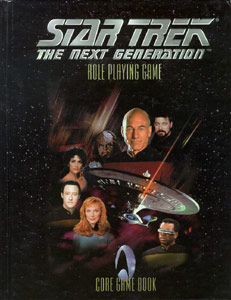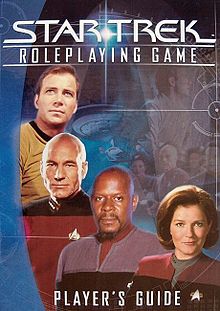Looking Back at the Various Star Trek RPGs
This isn't a full review of all the incarnations of Star Trek but rather some thoughts on my experiences with them. Modiphius has just announced that they will be producing a new Star Trek RPG which has gotten me talking with a number of people I know from previous incarnations.
So to begin, my background. Once upon a time (around 1975) I was a preschool and kindergarten kid living outside of Syracuse, New York. My mom would want a little bit of peace and quiet while she made dinner. And as it so happened, the show with the guy with the funny ears was on at that time, which apparently was capable of entertaining me. And the rest is history. I had no choice but to be a Trekkie.
FASA
I discovered the FASA game while I was in high school, had some games then and several more in college. FASA used a percentile based system married to using "Action Points" to keep track of action - every round you had a pool of action points you could spend, breaking down your round into minute detail. To be honest, we pretty much just ignored the whole action point thing... The skill system was a bit reminiscent of Call of Cthulhu now that I think of it, though Call of Cthulhu probably did a bit of a better job handling default skill ratings.
FASA Star Trek had two editions. The first edition was a bit less refined than the second, though the differences were pretty minor - I used 1st edition adventures with the 2nd edition pretty easily, without ever getting a copy of the 1st edition until the late 1990's. By default, the game assumed you were Star Fleet officers (the term evolving into Starfleet as time went on) in the period of the television series. No original series mind you - it was the only series for much of the FASA line. Supplements detailed the film period as well as traders, Klingons, Romulans, Orions, Intelligence Officers, etc.
When FASA first came out with their RPG I believe there was only the original series, the animated series, and I believe the first two films. They had to fill in a lot of details. They used a timeline which set the original Star Trek's first season as being in 2207-2208 if my memory is correct - certainly in the early 23rd century, something later material would contradict. They had to fill in details about the various rivals to the Federation. The Romulans were a spartan people who worshiped the "Great Brothers" - beings who transplanted them off of Vulcan in ages past. The Klingons were developed with John M. Ford of The Final Reflection and other works (including contributing to the Paranoia RPG). These Klingons viewed life as extension of the Komerex Zha - the great game. The Klingons of the films were "Imperial" Klingons while those of the television show were Klingon-human fusions - the idea being that they were genetically engineered to better understand and fight humans. Like much of what they developed, this was contradicted by the later material, but in this case they were fairly close to what actually came to be.
Their universe was a bit more militaristic than would later be portrayed, with military-only Starfleet vessels, Starfleet marines, etc. They lost their license early in Star Trek: The Next Generation's run after putting out a pair of references for that.
We had great fun using the FASA rules, both in the original era as well as in the TNG period as well. I wound up working out some pretty reasonable character generation options for Next Generation games. Character generation was definitely a highlight of the game - you had a lifepath system where you'd advance your character through the academy, cadet cruises, and tours of duty.
See also my review from 2012.
Last Unicorn Games
I'll always have a bit of a fondness for this incarnation of the game. I was fairly involved with the FASA Star Trek online community in the mid to late-1990's. I had my first webpage dedicated to reference material for the FASA game and had a fairly complete collection of ships on my old ziplink homepage.
This incarnation of Star Trek came out near the end of Star Trek's peak of popularity in the 1990's. Unlike the FASA game, it was designed around multiple games, somewhat like what Fantasy Flight Games is doing with Star Wars. The first game, Star Trek: The Next Generation was designed around Starfleet officers in the TNG period. Their other two games were Star Trek: The Original Series and Star Trek: Deep Space Nine. The DS9 game was a wide open game welcoming smugglers, mercenaries, freedom fighters, and Starfleet officers. While the authors took some liberties, overall these games stayed closer to canon. There were a number of interesting supplements produced in this period, detailing the Romulan Empire, the Andorians (a fantastic take on them, though sadly overridden by their role in Enterprise), Starfleet Intelligence, etc.
The LUG games took some cues from the FASA game - it kept some elements of the lifepath system. The task resolution was a little bit weird - you rolled a number of d6 equal to your attribute, kept the best one, and added your skill rating. And one die was an exploding drama die. And there was some weirdness in calculating specializations which I'd need to dig the books out of basement storage to figure out...
I was very active in the community that built up around LUG Star Trek, becoming one of the moderators at trek-rpg.net. I had numerous contacts with the designers of the games and its fans - even now, some 18 years later (!!!) I'm still in touch with a number of people I've met through the game. A LUG Trek game aboard the starship Icarus kicked off my post-college gaming, something which has endured all this time. I still laugh about the numerous discussions about the "Kirk's ass" combat maneuver, which we named from Captain Kirk's move in "Journey to Babel" where he attacked an Orion disguised as an Andorian ass-first... We also had a fun Bridgetown DS9 game where a partially functioning Iconian portal was discovered at a rough and tumble port.
Last Unicorn Games was acquired by Wizards of the Coast. It was an odd acquisition - the only product of it was a limited edition Dune RPG after which they lost the Star Trek license to Decipher. I've heard rumors that in the event of an acquisition Paramount could void the license but I've no idea to the truth of that...
Decipher
Breaking away from the multi-corebooks of the LUG line, the Decipher line, designed by many of the veterans of the LUG line, took many cues from the d20 system. It had some concepts akin to classes and levels, resistances that resembled saving throws, and lots of skills. From the corebook you could make lots and lots of characters. Task resolution was a bit less wonky than the LUG version with 2d6+skill rating used to resolve most tasks.
My group was involved in the playtest of the Decipher game. I don't think its a violation of the NDA that we were amused to discover a problem with the soak rules allowed a Klingon to walk away from a train landing on him. That rule was fixed in the released version. We discovered a Klingon game was a great way to really test out the action system. And it was a heck of a lot of fun.
The core book, the Player's Guide, had a good system but suffered organizationally - it was pretty tough to decipher (sorry about the pun) the proper steps to generate a character. Actual play was really smooth as I recall, though sadly I didn't get to play as much of this game as I did others. My gaming group went through a number of hiccups at this time, with people moving, people having kids (raises hand), people losing their jobs (raises hand). The line produced a number of supplements, but it seems Decipher was having some pretty big money problems which led to a rather awkward release schedule.
Perhaps my favorite part of the game for me was the Starships book. For two reasons - I love starships. And both the late Corgi Loki and I are Easter eggs in it. On the section about the Constitution-class, under notable starships you will find:
In 2269, under the command of Commodore Dan Stack, the Kongo successfully observed the primitive civilization on Muldoon IV, located between the twin stars Loki and Thor.








Comments
Post a Comment